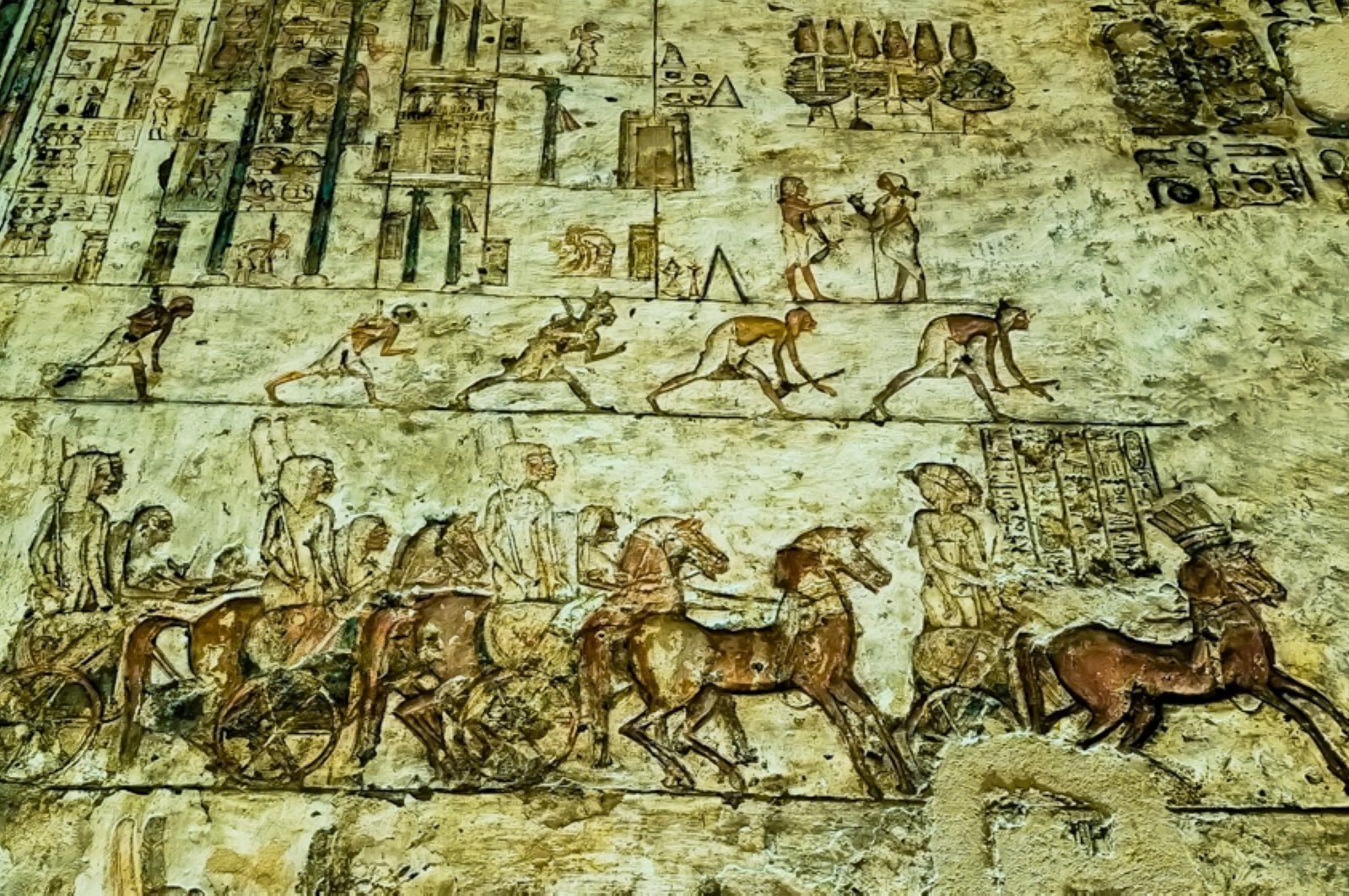We dived deep in the history of Tel El-Amarna with the previous post. Today, we will explore the city itself and what a visitor can see there. Excavation at the site continues with the current work of excavation, survey, and preservation under the auspices of the Egypt Exploration Society beginning in 1977. ‘The Amarna Project carries out its work at Tel El-Amarna through an annual permit from the Egyptian Ministry of Antiquities.
The majority of visitors to Amarna come by road, taking the Et-Till ferry from the west side of the Nile across river to the east bank or via a bridge over the Nile. Visitors to El-Amarna can explore:
The North Palace (The Palace of Nefertiti)
This was a self-contained residence of El-Amarna built along three sides of a long open space, which itself was divided by a wall and pylon. The residential part had gardens and reception rooms with columns along its rear. In the northeast corner is the most famous part of this residence, consisting of a garden court. A central chamber on the north side, known as the “Green Room”. This room was painted with a continuous frieze representing the natural life of the marshes. Each room has a window from which the sunken central garden could be viewed. In recent years, the walls have been somewhat restored and some of the missing column bases have been replaced with modern replicas. There were animal pens further to the west on the north side. As well as a court containing three solar altars, of which nothing now exists but their foundations.
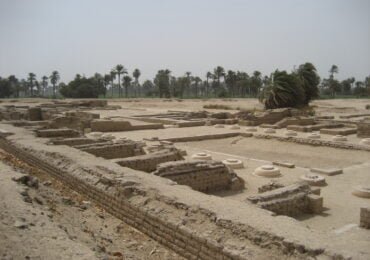
The Desert Altars
On the road to the North Tombs, one passes a watchmen’s house. A short distance to the west and north of this lie the remains of three large mud-brick solar altars in the form of square platforms, with ramps, that are known as the Desert Altars of El-Amarna. The northernmost of these had four ramps of well-rammed sand and probably an altar in the center.
The North Tombs of El-Amarna
The north tombs of El-Amarna are separated by a ravine into two groups. The most important tombs numbers 3 – 6 lie to the south. Taking the pathway up leads straight to tombs 3 – 5. Tomb 6 is reached by separate path up or by a track along the cliff face. Further unfinished tombs are located to the north of tomb 3.
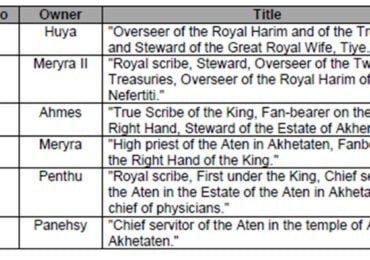
Remains of stone huts of the Christian community who lived here in the Late Roman Period can be seen between tombs 5 and 6. The spiritual center for this community was a church, created by modifying Panehsy’s tomb by enlarging it on the north-west side, and adding an apse at the end. Debris outside the tomb dates to the same period. Along the road that runs southwards from the North Tombs and parallel to the cliff. After 2km a turning to the left leads directly to one of the most impressive boundary Stelae, Stela U. Which measures about 7.6m from top to bottom and occupies almost the entire height of the cliff in a little bay to the north of the entrance to the Royal Wadi.
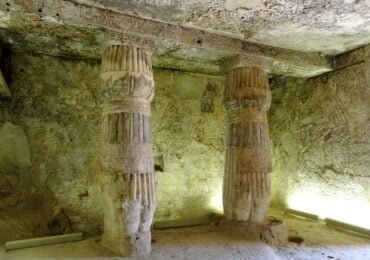
El-Amarna Royal Tomb
The Royal Tomb of El-Amarna (No 26) lies in a narrow side valley leading off from the Royal Wadi at a distance of 6km (nearly 4 miles) from its mouth. Its basic design and proportions are not unlike those of the royal tombs in the Valley of the Kings. However, it was intended for several people, including the king, princess Meketaten and probably Queen Tiye so there are additional burial chambers. There is also an unfinished annex that may have been intended for Nefertiti. Here, the quality of the rock is poor, and so the decorations of the tomb were cut into a thin layer of gypsum plaster. Hence, most of the decorations have not survived and most of what is left is in the chambers of princess Meketaten. Despite this, the impressive dimensions and dramatic atmosphere of the tomb make it well worth a visit.
On the south side of the main Royal Wadi are further large unfinished tombs. By their size and location, they seem to have also been intended for members of the Royal Family.
From Et-Till the Central City and the South Tombs are reached by an agricultural road that is sometimes of asphalt and sometimes of packed sand, gravel and dust. To begin with it runs not far from the edge of the cultivation as it passes actually along the line of a major ancient road through Tel El-Amarna.
The Central City of Tel El-Amarna
The Central City of El-Amarna starts just beyond the southern edge of the modern village and its large cemetery. The focal point for visitors is the Small Aten Temple, with its brick pylons and restored column, which acts as a landmark. The Amarna Project has laid out a visitor route with numbered markers, starting from in front of the Small Aten Temple.
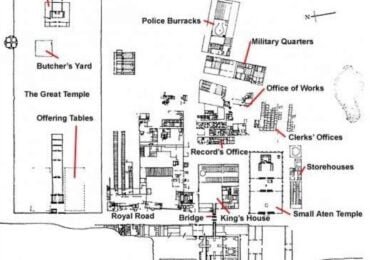
Southwards from the Small Aten Temple is The Main City, which was the principal residential area of the ancient city (Akhetaten). It was the part of the city occupied by the most important people (other than the king). Notables including the vizier Nakht, the high priest Panehsy, the priest Pawah, General Ramose. As well as the home and workshop of the sculptor Tuthmosis (Thutmose) where the famous bust of Nefertiti was discovered.
Visitors to El-Amarna can view the layout of one of the houses (House Q44) via a modern viewing platform. Although the owner’s name is unknown, based on size, the house is for a senior official. The ruins of grain silos can be seen here. The road continues southwards, past the remains of ancient brick houses mostly on the east side of the road. Just before the village of El-Hagg Qandil, a turning to the east heads directly towards the South Tombs, passing through a modern agricultural scheme.
El-Amarna South Tombs
Nineteen tombs are located in the south of Tel El-Amarna (numbered 7 – 25). These tombs were owned by a mix of officials including tomb no.25, belonging to the god’s father Ay. Who would later become pharaoh, this is the most southerly of the group.
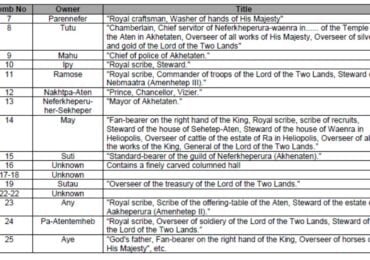
Many of the South Tombs contain little or no decoration and some had barely been started before the city was abandoned. Although, some were also used for later burials, and amongst them are pot shards mostly dating from between the 25th and 30th Dynasty.
The Workers Village of El-Amarna
To the east in a little valley on the south side of a low plateau that runs out from the base of the cliffs between the Royal Wadi and the southern tombs, there is the ‘workmen’s village of Tel El-Amarna’.
In its final stage the village proper was contained within a plain brick wall, approximately 69m square. A major internal subdividing wall and joins in the brickwork imply that the village was extended westwards during its life. So that it rose up the flank of the western side of the valley. A total of 72 houses of similar design were built along a series of parallel streets. They preserved the remains of furnishings and craft materials. A larger house in the south-east corner was presumably for the official in charge. The later addition also contained one larger house. The village came to have a single narrow entrance (a separate one to the later addition was walled up). Just inside the gateway a low rectangular pedestal could have been a shrine.
This was the story of Tel El-Amarna from nothing, when it was a arid area to its glory during the time of Akhenaton, to its death, when this special pharaoh died. The glory returned back to Thebes after death of this wonderful city of Akhetaton.
How to get to Tel El-Amarna from El-Minya?
To get to Tel El-Amarna from El-Minya, you have a few transportation options:
1. Private Car or Taxi
- Distance: Approximately 55 kilometers (34 miles).
- Travel Time: Around 1 hour.
- Route: You would take the main road south from El-Minya, following signs for Tel El-Amarna. The road is mostly straightforward, and the journey takes you through the scenic Nile Valley.
2. Public Transportation
- Option: You can take a minibus or shared taxi from El-Minya to Mallawi, a nearby town. From Mallawi, you can hire a local taxi to take you to Tel El-Amarna.
- Travel Time: This option may take longer, around 1.5 to 2 hours, depending on connections and waiting times.
- Cost: This is a more budget-friendly option, but it involves more transfers.
3. Guided Tour
- Option: Joining a guided tour from El-Minya is a convenient way to visit Tel El-Amarna. Egypt Best Vacations provide many tours offer transportation, a guide, and sometimes lunch.
- Benefits: You’ll have the convenience of a guide who can provide insights into the history of the site.
Regardless of your choice, it’s advisable to arrange transportation in advance, especially if visiting during peak tourist seasons.

